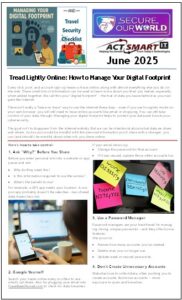Tread Lightly Online: How to Manage Your Digital Footprint
Every click, post, and account sign-up leaves a trace online, along with almost everything else you do on the web. These small bits of information can be used to learn more about you than you realize, especially when added together. We call this your “digital footprint” – the trail of data you leave behind as you navi-gate the internet.
There isn’t really a “leave no trace” way to use the internet these days – even if you use Incognito mode on your web browser, you will still need to have online accounts like email or shopping. You can still take control of your data, though. Managing your digital footprint helps to protect your data and boosts your cybersecurity.
The goal isn’t to disappear from the internet entirely. But we can be intentional about what data we share and where. Just as you would be mindful with the personal information you’d share with a stranger, you can (and should!) be mindful about what info you share online.
Here’s how to take control:
1. Ask “Why?” Before You Share
Before you enter personal info into a website or app, pause and ask:
• Why do they need this?
• Is this information required to use the service?
• What’s the benefit to me?
For example, a GPS app needs your location. A cou-pon app probably doesn’t. Be selective—less shared data means less risk.
2. Google Yourself
Search your name online every so often to see what’s out there. Also try plugging your email into HaveIBeenPwned.com to check for data breaches. If your email shows up:
• Change the password for that account.
• If it was reused, update those other accounts too.
3. Use a Password Manager
Password managers are your best friend for manag-ing strong, unique passwords—and they offer bonus features. Use yours to:
• Review how many accounts you’ve created.
• Delete ones you no longer use.
• Update weak or reused passwords.
4. Don’t Create Unnecessary Accounts
Websites love to collect data, often pushing you to create accounts. But more accounts = more exposure to spam and breaches.If you’re making a one-time purchase, use guest checkout. The fewer accounts you have, the smaller your footprint.
5. Review Privacy Settings
Some accounts (like Google, Apple, Facebook) are hard to avoid—but you can control how much data they collect.
• Review settings every few months.
• Limit what’s public (like who sees your posts).
Restrict data tracking and storage.
6. Know Your Privacy Rights
You may have legal rights to control your data:
• California’s CCPA gives residents rights to view or delete data collected by businesses.
• Europe’s GDPR offers strong protections for EU citizens. Stay informed—new laws may offer you more control.
7. Browse and Post with Care
Prevent problems before they start:
• Use private browsing modes when needed.
• Think twice before sharing personal info or post-ing on social media.
• Avoid sharing things like birthdays, addresses, and travel plans
TAKE CHARGE OF YOUR DIGITAL FOOT-PRINT
You don’t need to go off the grid to maintain your digital footprint. By taking small, intentional steps to reduce it, you can improve your data privacy, reduce the risk of scams and breaches, and build better online habits that will last a lifetime.
Special thanks to:
https://www.staysafeonline.org/articles/tread-lightly-online-how-to-check-and-manage-your-digital-footprint
Got a trip coming up?
Whether it’s business or vacation, we know how chaotic things get before you head out—closing up shop, packing bags, triple-checking flights. But here’s one thing most folks forget: cybersecurity.
Travel opens the door to all kinds of digital headaches. Public Wi-Fi, lost devices, shady charging stations—they’re all real threats. And if something goes wrong while you’re away, it can throw your whole business off track. So here’s a simple, no-fluff checklist to keep you protected on the go:
1. Lock Your Devices
Use strong passwords and biometric locks, and make sure your laptop and phone are encrypted. If they go missing, you want to be sure no one can get in.
2. Skip Public Wi-Fi
Those free airport and hotel networks? They’re hacker bait. Use your phone’s hotspot or a VPN. It’s like putting on gloves before touching anything suspect.
3. Watch Out for USB Ports
“Juice jacking” is a thing—hackers can steal your data through public charging stations. Stick to your own charger or use a USB data blocker.
4. Update Before You Go
Do all your software updates at home. They patch security holes, and it’s better than dealing with a slow hotel connection when something breaks.
5. Shut Off What You Don’t Need
Turn off Bluetooth, file sharing, and auto-connect. Less open doors means fewer chances for bad guys to sneak in.
6. Don’t Over-Share
Posting pics of your trip while you’re still gone tells the world you’re not home. Wait till you’re back to share the fun.
7. Back Everything Up
Before you leave, make a full backup of your files. If something goes sideways, you’ve got a copy waiting at home.
Travel should feel like a break—not a risk. A little prep now saves a lot of heartache later.
Safe travels!

Would you like a print copy of this infographic mailed to you?
Simply fill out the form below

